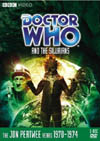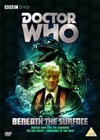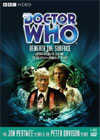DVD Extras include:
- Audio commentary by producer Barry Letts,
script editor Terrance Dicks, director Timothy Combe,
actors Caroline John (Liz Shaw),
Peter Miles (Dr. Charles Lawrence),
Nicholas Courtney (The Brigadier),
and Geoffrey Palmer (Edward Masters).
- "Going Underground" making-of featurette (19 min.) with
Letts, Dicks, Combe, Caroline John, Courtney, Miles,
and designer Barry Newbery.
- "What Lies Beneath" documentary (35 min.) on the influences on this story
as well as general sci-fi of the 50's, 60's and 70's.
- "Now and Then" location featurette (9 min.)
- "Musical Scales" featurette on the experimental music during 70's Dr. Who (14 min.)
- Colour Restoration featurette (4 min.)
- Isolated music by Carey Blyton
- Pop-up Production Note Subtitles
- Photo Gallery music montage (6 min.)
Buyers' Guide Review
by Martin Izsak
|
|
(A more in-depth analysis, containing "SPOILERS" and intended
for those who have already seen the program, can be accessed
here.)
|
Doctor Who really embraces its largest demographic - ADULTS - with this highly
mature-minded adventure, a fact nicely highlighted by producer Barry Letts on the
audio commentary as he sets the record straight on this show's actual and intended audience.
Through an extremely well-portrayed cast of colourful real characters, many perspectives
on important issues are brought up and milked for dramatic potential, producing an
adventure that keeps up a good pace throughout its long run. There are a few caveats,
as some of the philosophies, costumes, and music cues of the second half will appear somewhat
outdated by more modern standards, but by and large this remains one of the better stories
of one of the classic show's best seasons.
Doctor Who and the Silurians
The TARDIS makes no showing in this adventure whatsoever,
and is surprisingly neither needed nor missed. The Doctor is a
completely understandable character all the way through, without
us needing to know any real details of where he comes from or how
he got here, and all the other characters are at home in these
normal surroundings. Fulfilling the role of the Doctor's vehicle
of choice in this story is a bright yellow vintage roadster.
The Doctor introduces us to "Bessie", and lets us know that he's
made some modifications to her that will allow many humorous
"secret agent" moments to pop up throughout the series.
The Rise of Doctor Who's Social Conscience
This story marks a shift towards more "societally conscious"
content in the sci-fi series, an exploration of the social philosophies
and attitudes that define a culture and harmonize it with its neighbour,
with nature, and with the environment. We've seen the likes of this
trait before in stories like
"The Daleks" (story no. 2),
"The Aztecs" (story no. 6),
"Galaxy Four" (story no. 18) and
"The Savages" (story no. 26),
but here it gains
more weight via more mature levels of complexity. The characters
in "The Silurians" are really well developed, each one seeing the
world through his or her particular paradigm and acting on the
beliefs that follow. This is one of the great strengths of writer
Malcolm Hulke, who in particular is most widely associated with the
"societally conscious" writing tangent and seems to make it the
number one priority when crafting his stories.
Hulke misses a few key elements that limit his writing however.
For a detailed dissection of the story, with all the plot-spoilers
that that entails, read the in-depth analysis version of this review
here.
Briefly though, notice how often the characters of this story
fail to value the way another person
views the world, and fail to appreciate that other person's paradigm.
The best that most of them manage is to ridicule the way that
the other person thinks with some accuracy, which predictably only
creates more conflict.
Hulke expertly uses this conflict to his advantage, as it is a natural
source of increased friction and drama, and it provides many
opportunities to raise the stakes in the plot again and again.
However, it does tend to leave me itching to apply a good dose of
Stephen Covey's "7 Habits of Highly Effective People",
with all the
overlapping paradigms and true seeking to understand one
another that that would entail.
The Doomsayer
Hulke is already beginning to limit the Doctor's heroics to
"Doomsaying". He has his hero state a problem correctly,
with punctuated emphasis, as though that in itself is a great
achievement. Well how about some solutions?
Doomsaying is not enough to
impress me very much.
"Good. Only it is rather like the reptile house in the zoo,
isn't it?"
Hulke's love of reptiles begins to show on Doctor Who in this
story, and will continue through the rest of his offerings to the
program. Despite the production team kicking themselves for not
having used a puppet T-Rex enlarged through CSO, Timothy Combe
makes very good use of the man-sized version he gets, and viewers
everywhere might be glad that the beast turned out so well in the
end. Combe proves adept in getting the best out of a good cast
playing straight, completely understandable characters experiencing
dramatic events. Peter Miles, Norman Jones, Thomasine Heiner,
and Geoffrey Palmer all put in top notch, enjoyable performances. Paul
Darrow, most famous in sci-fi circles for playing Avon on Blake's 7,
is on hand to take his turn as the Brigadier's right hand Captain
in this one, and manages to look like better army officer material
than ex-army officer turned actor Richard Franklin. Peter Halliday
is on hand to do monster voices, and does a vastly better job of the
Silurians here than he did of the Cybermen (or Packer) in
"The Invasion" (story no. 46),
probably due in large part to the fact that he is
allowed to put lots of emotion into the voices. "Silurians" give us
perhaps the best of Caroline John as Liz Shaw, and as far as season
seven goes, the best of Nicholas Courtney as the Brigadier. The very
top acting marks, however, must go to Fulton MacKay and Jon Pertwee,
whose playing off of each other is the greatest fun to behold.
|
Musically, Carey Blyton starts off on an excellently spooky
stride ("In the Caves"), and manages to achieve some strikingly
good and memorable
stuff before the adventure is over, not least of which includes
lighter morning music for Squire's farm ("A Close Encounter"),
a mock-important UNIT military theme ("March: The Brigadier"),
and a lovely bit of primitive tinny percussion
that effectively encapsulates the Silurians' view of human beings.
(Most of these feature in re-recorded, expanded arrangements on the
CD pictured at right).
However, many of the later stings and linking cues are extremely
jarring, the most memorable being a thematic Silurian phrase of
three identical notes followed by three ascending or descending ones.
Although
in danger of making the Silurians seem tired and listless as it
gets attached to them, this phrase-theme can and does work on menacing
and cultural moods in various places in the story. More often than
not it is played on some instrument that sounds like a kazoo with
little or no accompaniment, and on these occasions it does not work
at all, sticking out like a sore thumb and even interrupting some
scenes like an alarm siren without a cause. "Silurians" winds up
containing some of the best of the season's music along with its
absolute worst.
|
Music by Carey Blyton
3 re-recorded tracks expanding on the main themes
of the score feature on:
|
|
The ancient globe depicting all of the continents on one side
is almost laughable if you stop to think about it, although the
production staff of Doctor Who is no worse off than the bulk of
the scientific community of the time for not thinking about it.
Water seeks its own level, right? This is simple enough to visualize
on a relatively flat piece of land, but on a 3D model like a planet,
the centre of gravity should be the defining factor for exactly where
the drop of ocean will coagulate around the Earth's solid portions.
With all known continental mass on one side, (often labeled as
a super-continent named "Pangea"), the centre of gravity should
shift slightly towards that side, pulling the Earth's ocean
over that way just enough to flood over some of that land mass,
and leave some previously unrecognized pieces of land sticking out
on the other side as unknown continental masses. Names from mythology
like Atlantis, Lemuria, and Mu spring to mind to fill the void gap
of this unknown, and huge ocean shifts like these give credence to
astronomical evidence of the Earth wobbling on its rotational axis
over long periods of time. My personal theory is that substantial
land mass MUST stick out on the other side of this ancient "Pangean"
Earth for the ocean to achieve gravitational balance. We can at least
thank this story for bringing up interesting subjects!
"Silurians" is extremely memorable for its ending - not so
much its dramatic climax as the aftermath. Perhaps we have
Terrance Dicks to thank for that as well as the last minute
addition of Bessie throughout the script. The Doctor's yellow
roadster is a most welcome addition to the mythology of the show,
and this adventure is a big winner in the end, one of the very
best of the Pertwee era and of Malcolm Hulke's work as well.
This story is available on DVD and VHS video.
If you've only seen it on TV in black and white syndication,
get yourself the re-colourized video and enjoy it
the way it was meant to be seen!
Single Story versions:
 |
 |
 |
DVD NTSC Region 1
for the North American market:

 in the U.S.
in the U.S.

 in Canada
in Canada
|
DVD PAL Region 2
for the U.K.
See box set below
|
VHS Video, re-colourized
NTSC

 for North America
for North America
PAL

 for the U.K.
for the U.K.
|
"Beneath the Surface" 3-story boxed sets:
(Story Nos. 52, 62, & 131: The Silurians,
The Sea Devils, & Warriors of the Deep.)
|
 |
 |
DVD NTSC Region 1
"Beneath the Surface"
3-story box set

 in the U.S.
in the U.S.

 in Canada
in Canada
|
DVD PAL Region 2
"Beneath the Surface"
3-story box set

 for the U.K.
for the U.K. |
Comments on this article are welcome. You may contact
the author from this page:
Contact page
|










